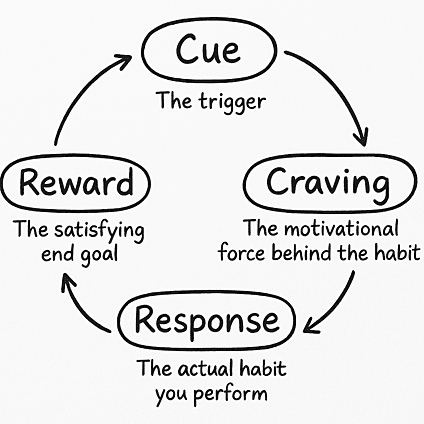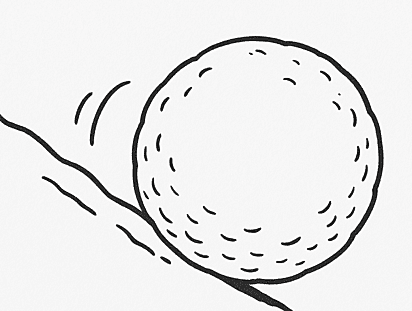
Summary
Loading summary...
My Challenge With Habits
But by the time March rolls around, that shiny membership card is buried somewhere in my wallet—just like last year’s... and the year before that.
Sound familiar? If you've ever struggled to build better habits, you’re not broken—and you're definitely not alone. The truth is, forming lasting change isn’t about willpower or motivation; it’s about understanding how your brain actually works.
Welcome to The Science of Habit Formation: How to Rewire Your Brain for Success. In this post, we’ll explore why most habits fail, what neuroscience tells us about behavior change, and how you can hack your brain’s natural wiring to finally make good habits stick—for good.
What's Really Controlling Your Day?
Think about your morning so far. How much of what you did was on autopilot?
That first reach for your phone... how you brushed your teeth... how you made coffee...
Weird to think about, right? These automatic behaviors aren't random. They're neurological shortcuts your brain creates to save mental energy – and they silently guide roughly half of your daily work.
You can flip the script once you understand how these habits form in your brain—scientists and "habity" people tell us. Instead of letting bad habits dictate your actions, you can build good ones that push you toward your desired life.
The Habit Loop: Your Brain's Hidden Operating System

So, what's really happening when habits form? Charles Duhigg, who wrote "The Power of Habit," broke it down into a three-part cycle that plays on repeat all day long:
The Cue: That trigger telling your brain to run a particular program (like feeling stressed)
The Routine: The behavior itself (reaching for your phone)
The Reward: The payoff that makes your brain go, "Hey, let's remember this trick!" (that little dopamine hit)
The interesting part? This process runs through your basal ganglia—a primitive brain region that handles automatic behaviors. Think of it as your brain's dance coach—it helps you move smoothly, unlike a malfunctioning robot. Your conscious mind checks out once the pattern locks in, putting you on autopilot.
Duhigg bluntly says, "When a habit emerges, the brain stops fully participating in decision-making." That's why even when you swear you'll stop scrolling before bed, you somehow find yourself still awake at 1 AM watching strangers renovate houses.
Neuroplasticity: Your Brain's Superpower (That Nobody Told You About)

So here is the good news: your brain isn't hardwired like a circuit board; it's more like a gelatinous substance—think Play-Doh.
This concept—called neuroplasticity—means your brain physically reorients itself based on what you repeatedly do. Each time you perform a new behavior, specialized cells called neurons form new connections. With repetition, these paths get stronger and become... habits.
Neuroscientist Norman Doidge calls neuroplasticity "one of the most extraordinary discoveries of the twentieth century" in his book "The Brain That Changes Itself." This adaptability means your brain remains remarkably flexible throughout your life—not just when you're young.
Let that sink in—there is hope for humanity. It means we're not stuck with our bad habits. We can carve new neural pathways that make better choices feel as automatic as the bad ones once did.
Why Bad Habits Are So Hard to Break
If our brains are so adaptable, why do bad habits feel impossible to kick?
It all comes down to dopamine—your brain's "feel good" chemical.
When you stress-eat a pint of Ben & Jerry's ice cream, binge-watch until 3 AM, or check social media for the 47th time today, your brain gets flooded with dopamine, making you feel rewarded and scratching the itch. Your brain doesn't care if the behavior is good for you long-term—it just knows it feels good right now.
That's why willpower alone rarely works. You're not just fighting lousy behavior—you're battling a primal reward system that's been perfected over millions of years of evolution.
James Clear's Four-Stage Habit Cycle

In "Atomic Habits," James Clear builds on Duhigg's framework, making a key distinction that helps turn the tide in new habit adoption:
Cue: The trigger
Craving: The motivational force behind the habit
Response: The actual habit you perform
Reward: The satisfying end goal
This revised framework breaks down what Duhigg called the "Routine" into two separate stages: Craving and Response.
That shift matters—it sheds light on why some habits are more challenging to change than others.
More importantly, it gives us additional influence points to build better habits or break bad ones.
How to Build Good Habits That Last
After numerous cycles of enthusiasm followed by abandonment, I've reached an epiphany: I need to work with my brain, not against it, to make habits stick.
So here's how I'm currently approaching habit change. To be clear, I'm not fully there yet, but I'm making progress.
I've concluded that my most significant error was—and has always been—trying to do too much at once. Research shows that "micro-habits"—actions so tiny they seem almost laughable—build momentum far more effectively than ambitious goals.
James Clear writes in Atomic Habits that we should make habits "so easy you can't say no." Instead of "exercising for an hour daily," try "doing one pushup after brushing your teeth."
This approach sounds absurd until you try it. That single pushup triggers the same neural pathways as a complete workout—without alarming your brain to resist it. It's OK if you stick with that micro habit for a bit. Likely, you'll do more than just one pushup on most days – dare to try two!
Getting over that initial hump—starting—is the key.
It's like an old truck on a cold winter morning. It may take a few cranks of the engine to get it going, but once it does, it will purr like a kitten. Once you've ingrained that in your wet wear, you should be ready.
The epiphany for my morning routine was Clear's discussion of habit stacking—hooking a new behavior onto an existing one firmly in place. Your current habits have already carved out their niche in your neuroplastic brain, making them perfect launch pads for expanded and/or newer habits.
James Clear offers a helpful formula:
"After I [insert current habit], I will [insert new habit]."
I like the approach; it takes what works and builds on it.
The only thing it is missing is something we use in Agile User Story writing: the desired outcome. While not a necessary component, for me, it makes more sense to include it:
After I [insert current habit]
I will [insert new habit]
So that [insert desired outcome]
While the User Story analogy doesn't work entirely, the "As a [insert role]" beginning statement is unnecessary, and the "So that..." closing component rounds out the phrase and provides more incentive.
So here are a few I'm working on:
After I wake up
I will drink 16 ounces of water right away
So that I jump-start my body's hydration
Or this one:
After I finish my work day
I will close my eyes and meditate for two minutes
So that I can focus on my family when I get home
Habit stacking leverages your brain's existing patterns and makes augmenting them with new habits easier.
I still struggle with this, especially when eating Lay's Baked Cheddar and Sour Cream chips. After countless failed attempts to avoid late-night snacking, I've concluded that willpower alone is no match for the environment. It's like putting David up against Goliath and then taking away his sling—he's defenseless.
The most effective approach? Make it impossible to do bad and easy to do good habits, such that the good habit routine is your default. Want to stop eating late chips at night? Here are some options:
Don't buy any (start with this one)
Go to bed earlier so you don't get the craving
Substitute for a healthier option like a pickle or celery
Drink a full glass of water
Want to read more?
Place a book on your pillow, so it's the last thing you do before sleeping
Time block 15 minutes at the same time every day
Download the audiobook and listen while commuting
This approach overcomes the need for willpower by removing the cues that trigger unwanted habits.
My wife, in her genius, often tells me that I am an all-or-nothing person. Did you miss one workout? You should throw in the towel until next month. Wrong.
Discovering the "two-day rule" helped me. The concept is simple: never skip your habit twice in a row.
Did you miss a day? No worries - life happens. Did you miss a second day? Now, it's a new habit that you need to fix.
I've learned this hard: one missed day is a blip, but two becomes a pattern. Your brain is forming new connections when you're building habits. That second consecutive miss is like unplugging the neural pathway just as it's starting to take hold.
What I love most about this approach is that it's realistic for my messy, imperfect life. It's not about being perfect—it's about not letting temporary setbacks become permanent ones.
I have a strange sense of pride when checking boxes—it makes me feel as if I'm making progress. There's something satisfying about seeing an increasing number of little check marks on a page.
While some writers prefer the old-school pen-and-paper method, I'm a digital nomad who does everything on my computer or phone. I need an app, and there are many good ones out there.
The psychology behind it is fascinating. Each X or ✓ gives your brain a tiny hit of dopamine that says, "Good job!" But here's the real kicker—once you've got a streak going, your brain likes it and wants to keep it going. I've returned to my home office at night more than once to close out a key item. We'll fight harder not to lose something than we will to gain something new.
Try it. Get persnickety about checking your boxes.
For years, I misunderstood rewards, thinking they needed to come after weeks of consistent behavior. Neuroscience suggests the opposite: immediate rewards strengthen neural pathways much more effectively.
After completing your new habit, give yourself a small, instant reward. This could be as simple as a moment of celebration, listening to your favorite song, or marking your habit tracker. Just make sure it's a healthy reward and not a bad habit masquerading as a reward—e.g., eating a chocolate bar every time you reach a milestone.
Eventually, the intrinsic feeling of success from performing the habit (like feeling satisfyingly fatigued after exercise) will replace the need for external rewards.
What Happens When Things Get Hard (Key Challenges)

Even with the best strategies, habit formation isn't always smooth sailing. Here are the obstacles that tripped me up most often:
The Plateau Effect
Initially, new habits bring noticeable improvements, but progress eventually slows. Scientists call this the Plateau Effect, and it can feel incredibly demotivating, though it is virtually guaranteed to happen.
The key is to expect plateaus and take them in stride, understanding that they are stepping stones to a higher level. Just keep pushing through by introducing slight variations to keep engagement high. When walking around the lake near my house, I change directions each time—from clockwise to counter-clockwise. Though subtle, it changes my view of the walk and makes it more enjoyable. It's also better for my gate, as it evens the sometimes tilted walking path.

Decision Fatigue
By evening, your mental energy for decision-making is at its lowest. This is why morning habits tend to stick better than evening ones.
Combat this by automating decisions: lay out tomorrow's workout clothes tonight, pre-plan meals, or set specific times for essential habits. I used to watch a lot of fiction shows at night to relax, such as The Wheel of Time. Now that I'm focused on building this blog, I'm more interested in honing my craft. This has led me to watch YouTube channels to improve my blogging and marketing practices.
Social Influences
The five people you spend the most time with powerfully influence your behaviors. If your friends order takeout every night while you're trying to cook more at home, you're fighting an uphill battle.
I've found it essential to spend time with people who embody the habits I want to develop—even if that means joining online communities or finding accountability partners with similar goals.
Compound Effects: Small Habits, Massive Results

The most potent aspect of habit formation isn't the individual actions themselves but their cumulative impact. Habits operate as compound interest for personal development—tiny daily improvements yield remarkable long-term transformation.
James Clear writes that improving just 1% daily makes you 37 times better after a year. He explains that "habits are the compound interest of self-improvement"—a concept that completely transformed how I approach personal change.
Looking at it through this lens, even the smallest positive choices become investments in your future self. That one pushup might seem meaningless today, but it's building neural pathways that will pay dividends for years.
Your Blueprint for Lasting Change

After years of starting and stopping, I've learned that habit change isn't about motivation or willpower. It's about understanding how your brain works and setting up systems that work with your neurological wiring, not against it.
By starting ridiculously small, stacking habits strategically, designing your environment, embracing flexibility, tracking progress visually, and rewarding yourself immediately, you can literally rewire your neural pathways to support the life you want.
Remember, habit formation isn't just about behavior change but identity shift. The most potent habits emerge when they align with how you see yourself. This became apparent to me when I stopped drinking in January—I became a non-drinker.
As someone who's been through the cycle of habit formation and abandonment more times than I care to admit, I can tell you the science-based approach works when nothing else does. Your brain is remarkably adaptable – it just needs the proper blueprint.
So, what tiny habit could you start today? Something so small you can't possibly fail?
That's where lasting change begins.
References
Duhigg, C. (2012). The Power of Habit: Why We Do What We Do in Life and Business. Random House.
Clear, J. (2018). Atomic Habits: An Easy & Proven Way to Build Good Habits & Break Bad Ones. Avery.
Fogg, B.J. (2020). Tiny Habits: The Small Changes That Change Everything. Houghton Mifflin Harcourt.
Doidge, N. (2007). The Brain That Changes Itself: Stories of Personal Triumph from the Frontiers of Brain Science. Viking.
